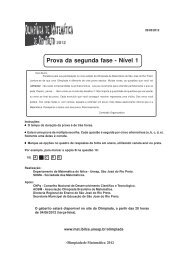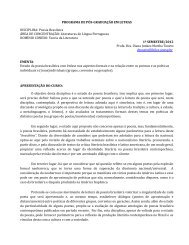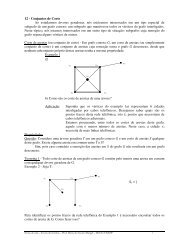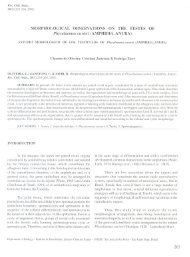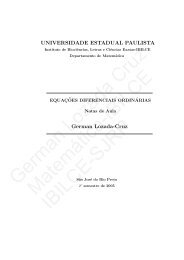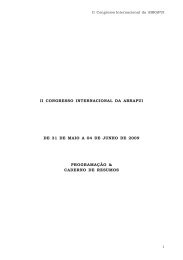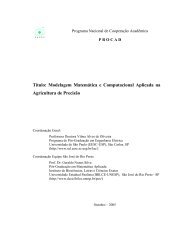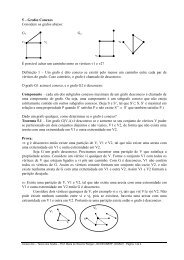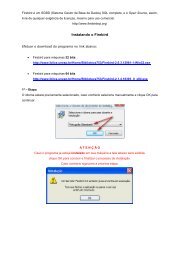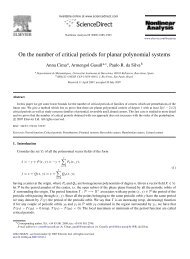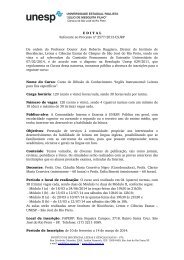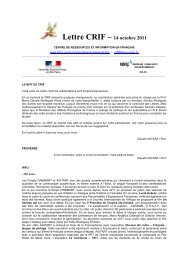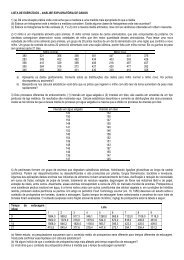Curso de Equações Diferenciais Ordinárias - Unesp
Curso de Equações Diferenciais Ordinárias - Unesp
Curso de Equações Diferenciais Ordinárias - Unesp
You also want an ePaper? Increase the reach of your titles
YUMPU automatically turns print PDFs into web optimized ePapers that Google loves.
2) Faça um esboço do comportamento dos seguintes campos polinomiais:<br />
a)X (x, y) = ( −x 2 , −2y 2) d)X (x, y) = ( −4x 3 + 6x 2 − 2x, −2y )<br />
b)X (x, y) = ( x 2 − y 2 , 2xy ) e)X (x, y) = ( x, −y + x 3)<br />
c)X (x, y) = ( x, x 3)<br />
3) Obtenha explicitamente a trajetória maximal <strong>de</strong> X : R n → R n por x 0 ∈<br />
R n e t 0 ∈ R arbitrários, nos seguintes casos:<br />
a)n = 1 e X (x) = x 2 d)n = 2 e X (x, y) = (2x, y)<br />
b)n = 2 e X (x, y) = (−y, x) e)n = 2 e X (x, y) = ( x 2 , 2y )<br />
c)n = 2 e X (x, y) = (−x, y) f)n = 3 e X (x, y, z) = ( −y, x, − 1 2 z)<br />
4) Escreva a EDO <strong>de</strong> segunda or<strong>de</strong>m como sistema autônomo plano e ache<br />
todos os pontos singulares:<br />
a)x ′′ + 9 sin x = 0 d)x ′′ + (x ′ ) 2 + 2x = 0<br />
b)x ′′ + x ′ (1 − x 3 ) − x 2 = 0 e)x ′′ + 4x<br />
1+x<br />
+ 2x ′ = 0<br />
2<br />
c)x ′′ + x = εx 3 , ε > 0<br />
5) Encontre as trajetórias e esboce o retrato <strong>de</strong> fase dos seguintes campos<br />
lineares:<br />
[ ] 1 2<br />
a)<br />
4 3<br />
[ ] −4 2<br />
b)<br />
− 5 2<br />
2<br />
[ ] 10 −5<br />
c)<br />
8 −12<br />
[ ] 0 2<br />
d)<br />
8 0<br />
[ 1<br />
]<br />
e) 2<br />
9<br />
1<br />
f)<br />
2<br />
2<br />
[ −6 2<br />
−3 1<br />
6) Usando coor<strong>de</strong>nadas polares encontre as trajetórias dos campos dados,<br />
passando pelos pontos dados. Descreva o comportamento geométrico.<br />
(<br />
a)X (x, y) = −y − x ( x 2 + y 2) 2 (<br />
, x − y x 2 + y 2) ) 2<br />
, p = (4, 0)<br />
b)X (x, y) = ( y + x ( x 2 + y 2) , −x + y ( x 2 + y 2)) , p = (4, 0)<br />
c)X (x, y) = ( −y + x ( 1 − x 2 − y 2) , x + y ( 1 − x 2 − y 2)) , p = (1, 0)<br />
(<br />
x (<br />
d)X (x, y) = y − √ 4 − x 2 − y 2) y (<br />
, −x − √ 4 − x 2 − y 2)) ,<br />
x2 + y 2 x2 + y 2<br />
p = (1, 0) e p = (2, 0)<br />
]<br />
96



